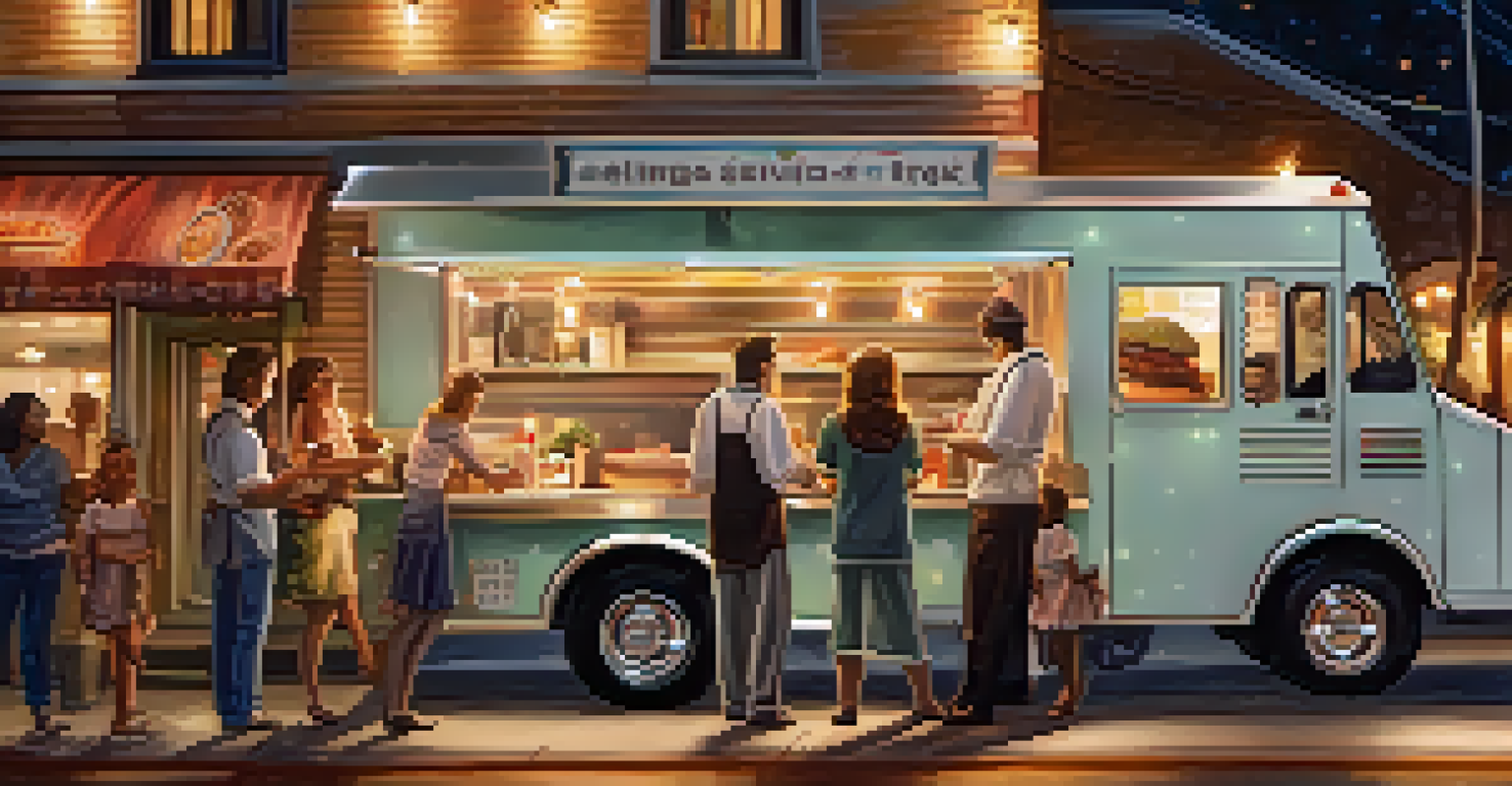Street Food and Social Media: The New Food Revolution

The Rise of Street Food Culture in the Digital Age
Street food has long been a staple of urban life, but in recent years, it has exploded in popularity thanks to social media. Platforms like Instagram and TikTok have turned food vendors into celebrities, showcasing their unique dishes to a global audience. This shift is not just about the food itself but also about the experience and culture surrounding it.
Food is not just what we eat, but a way to connect with people and culture.
As people share their street food adventures online, they create a sense of community and excitement that draws others in. A delicious taco stand or a vibrant food truck can become a viral sensation overnight, attracting food lovers from all walks of life. This phenomenon emphasizes how social media can elevate local cuisine to international fame.
Moreover, street food markets have become hotspots for social interaction, with food enthusiasts gathering to discover new flavors and share their experiences. It’s not just a meal; it’s a shared adventure, fueled by the visual appeal of food photography and the ease of sharing through digital platforms.
Social Media Platforms: Transforming Food Discovery
Social media platforms are reshaping how we discover street food. Instead of relying solely on traditional methods like word of mouth or guidebooks, food lovers now turn to social media feeds to find their next meal. Hashtags like #StreetFood and #Foodie help users navigate a vast landscape of culinary options, often leading them to hidden gems.

For instance, a simple post showcasing a mouthwatering dish can spark curiosity and prompt followers to seek out that vendor. This instant access to information creates a sense of urgency, where missing out on a trending food item feels like a lost opportunity. In this way, social media acts as a powerful catalyst for food exploration.
Social Media Boosts Street Food Fame
Platforms like Instagram and TikTok have turned street food vendors into celebrities, showcasing their unique dishes and creating a sense of community around local cuisine.
Additionally, influencers play a pivotal role in this discovery process. They curate experiences, recommend spots, and provide honest reviews, which can significantly impact a street food vendor’s popularity. Their endorsements often translate to increased foot traffic and sales, reinforcing the symbiotic relationship between social media and street food.
Creating Visual Appeal: The Art of Food Photography
One of the key elements driving the street food revolution on social media is the emphasis on visual appeal. High-quality food photography can make a simple dish look irresistible. Vendors are now more aware than ever that presentation matters; a colorful dish can capture attention and drive engagement online.
Social media is not just a tool for communication, it's a new way of sharing experiences and culture.
Consider how a perfectly plated bowl of ramen or a towering burger can entice viewers scrolling through their feeds. This visual storytelling not only highlights the food itself but also reflects the vendor's creativity and passion. The more visually stimulating the dish, the more likely it is to be shared and talked about.
Moreover, the rise of platforms like TikTok has introduced a dynamic element to food presentation. Quick, engaging videos showcasing the food preparation process can captivate audiences and encourage them to seek out the real thing. Thus, vendors are finding innovative ways to combine culinary art with digital storytelling.
Engagement and Community Building Through Food
Social media has also become a powerful tool for street food vendors to engage with their customers directly. Through comments, likes, and shares, vendors can connect with their audience in a way that was previously unimaginable. This interaction fosters a sense of community, making customers feel like they are a part of the brand.
For example, many vendors use their social media platforms to share behind-the-scenes content, cooking tips, or even personal stories about their culinary journey. These glimpses into the vendor's world can create a deeper emotional connection with their audience. When customers feel personally connected, they are more likely to support these businesses.
Visual Appeal Drives Food Engagement
High-quality food photography and dynamic videos capture attention and enhance the sharing potential of street food, making visual presentation a key element of its success.
Moreover, social media allows for real-time feedback, enabling vendors to adapt their offerings based on customer preferences and trends. This responsiveness not only improves customer satisfaction but also builds loyalty and encourages repeat business.
The Impact of Food Trends on Street Food Vendors
Food trends often emerge from social media, influencing what people want to eat and how they perceive street food. For example, the rise of veganism and sustainability has prompted vendors to adapt their menus to cater to these preferences. This shift not only meets consumer demand but also showcases the versatility of street food.
As a result, vendors are experimenting with innovative recipes, incorporating local ingredients, and even creating fusion dishes that blend different culinary traditions. This trend not only attracts a diverse audience but also enhances the overall street food scene, making it more exciting and dynamic.
Moreover, vendors who stay ahead of food trends can benefit from increased visibility and sales. By leveraging social media to promote their trendy offerings, they can position themselves as leaders in the street food revolution, drawing in curious foodies eager to try the latest craze.
Challenges for Street Food Vendors in the Digital World
While social media offers numerous opportunities for street food vendors, it also presents unique challenges. The pressure to maintain an online presence can be overwhelming, especially for small business owners who may not have the resources or expertise. Balancing day-to-day operations with social media obligations can be a daunting task.
Additionally, negative feedback can spread just as quickly as positive reviews. A single bad experience shared online can tarnish a vendor’s reputation, making it crucial for businesses to manage their online image proactively. This necessitates a focus on customer service and quality to minimize potential backlash.
Adapting to Trends is Crucial
Street food vendors must stay agile and embrace emerging trends, such as veganism and sustainability, to meet consumer demand and thrive in the competitive landscape.
Moreover, the fast-paced nature of social media means that trends come and go quickly. Vendors must stay agile and willing to adapt, constantly reinventing their offerings to keep up with changing consumer preferences. This can be both exciting and exhausting, highlighting the importance of resilience in the ever-evolving food landscape.
The Future of Street Food and Social Media
Looking ahead, the relationship between street food and social media shows no signs of slowing down. As technology continues to evolve, so too will the ways in which we discover and engage with our favorite food vendors. Innovations in food delivery services and online ordering systems will further bridge the gap between digital and physical dining experiences.
Additionally, augmented reality (AR) and virtual reality (VR) may soon play a role in how consumers interact with street food. Imagine being able to virtually step into a food truck and see how your dish is prepared before placing an order. These advancements could revolutionize the way we experience street food and enhance the excitement.

Ultimately, the future of street food is bright, fueled by creativity, community, and the endless possibilities that social media presents. As vendors continue to innovate and adapt, they will undoubtedly shape the culinary landscape for years to come, making street food an integral part of our cultural experience.